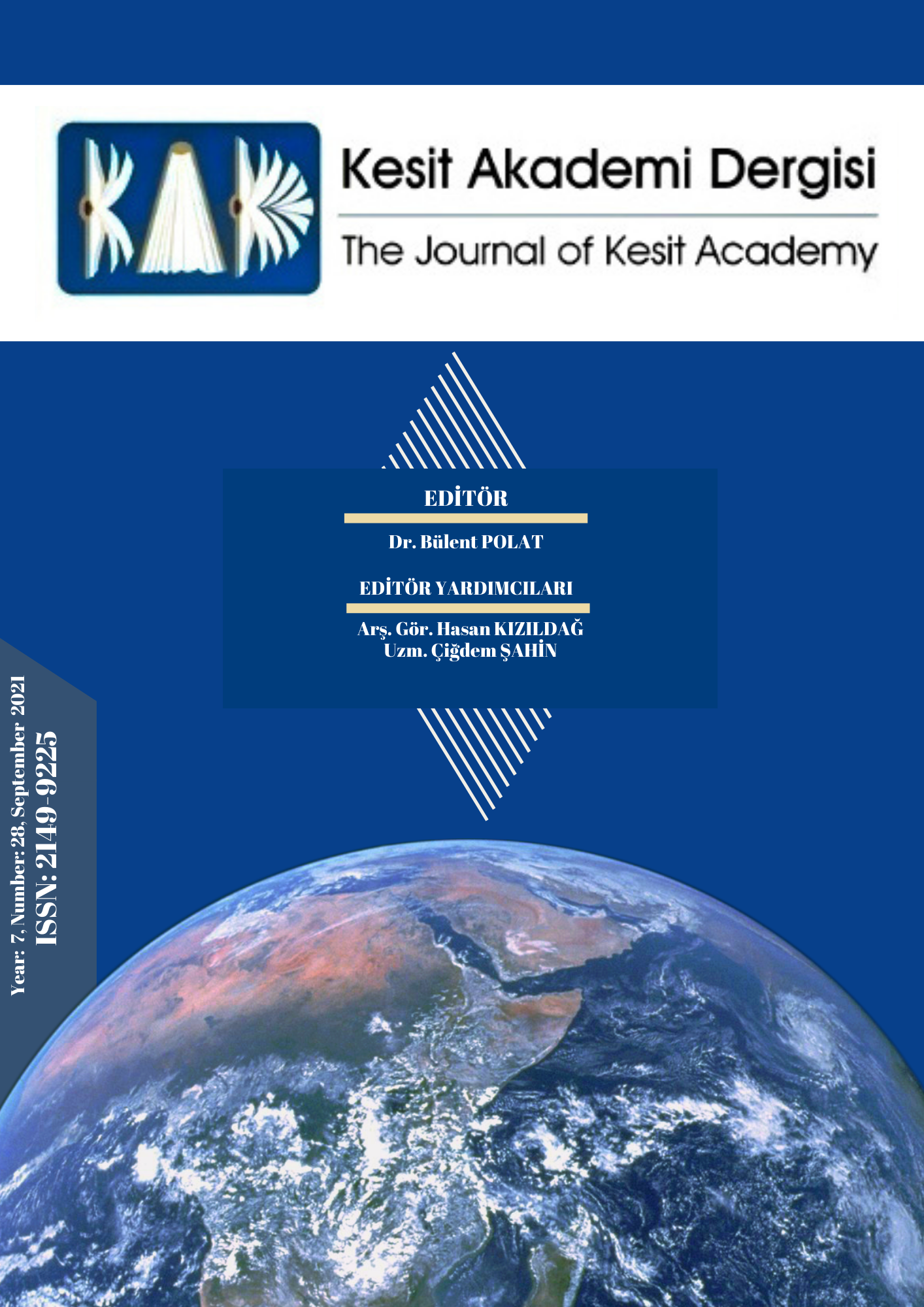Author :
Abstract
1960’larla birlikte gündeme gelen çizim ve performans melezlenmesi, yüzeyde bir iz bırakmaya odaklı olan çizim sanatının sınırlarını belirgin şekilde ortadan kaldırmıştır. Çizmek için performansı bir ara dil olarak kullanan sanatçıların önemli bir temsilcisi olan Judith Braun’un sanatı, temellerini bu süreçten alır ve eklenmelerle gelişir. Çalışma kapsamında performatif çizimlerinde özellikle parmak izi kullanımına yer verdiği görülen sanatçının sanatı, biçim ve içerik açısından ele alınırken, sanatçının imge seçimleri ve biçim dilinde karşımıza çıkan eğilimlere göz atılmıştır. Bu bağlamda güncel sanatta parmak izi kullanımı, çalışma kapsamında sanat eserine biriciklik değeri kazandıran bir yapı olarak incelenmiş ve çeşitli eserler ile bu vurgu güçlendirilmeye çalışılmıştır. Öyle ki; kimlik tanımlama ve güvenlik protokolleri için veri oluşturma amacıyla tarih boyunca geleneksel yaklaşımlar ve dijital teknolojiler aracılığıyla araştırılan ve geliştirilen bir alan haline gelmiş parmak izi, sanat tarihsel süreçte de oldukça ilgi çekmiş, hatta bir biçimlendirme dili olarak kullanılır hale gelmiştir. Parmak izi kullanımını bir biçimlendirme dili haline getiren Judith Braun’un simetri, soyutlama ve kömür tozu kullanımı olarak üç ayrı başlık altında toparladığı parmak izi serileri üzerinden, bizi sıklıkla sanatta biriciklik kavramı ile ilişki kurmaya davet eden ve plastik açıdan oldukça zengin öğeler barındıran sanatsal dili; makale, video ve internet sitelerine başvurularak çeşitli sınıflandırmalar ve amaçlı örneklemeler yoluyla ele alınmıştır. Bu amaçla malzeme olarak karbonu tercih etmesi, çizimlerini oluştururken simetrik kompozisyonlar kurmaktaki ısrarcı yaklaşımı ve soyutlama hakkında düşünceleri incelenmiştir.
Keywords
Abstract
The hybridization of drawing and performative arts in the 1960s has significantly eliminated boundaries that mainly focused on leaving a mark on the surface. As a renowned representative of artists who used performance as an intermediary language in their drawings, Judith Braun's art is grounded on and grows out of this process. In this study, within the framework of three main titles that the artist is focusing on in her mainly fingerprint-heavy performative drawings, this study examines the formal and contextual aspects of her work while glancing at the inclinations in terms of imagery selection and formal language. This study focuses on the use of fingerprints in contemporary art as an element adding uniqueness to work itself while supporting this emphasis through various artworks. So that; having been inspected and developed through traditional approaches and digital technologies to create a database for identification and security protocols throughout history, fingerprint analysis has also evolved into a formative language while arousing interest in the art historical process. Frequently inviting the viewer to create associations with the concept of uniqueness in art, the artistic language of Judith Braun, who has made the use of fingerprints a formative language,—which she groups under the three categories of symmetry, abstraction, and charcoal—as well as her artistic language enriched with many plastic components, have been explored through classification and purposeful sampling, referring to articles, videos, and websites. Accordingly, the choice of carbon-based media and the persistent approach of using symmetry in her compositions, and her view on abstraction have established the focus of this study.
Keywords
- Barutçu S. (2008). Parmak izlerinin adli antropolojik incelenmesi [Fen Bilimleri Anabilim Dalı Yüksek Lisans Tezi]. İstanbul Üniversitesi.
- Benjamin, W. (1993). Tekniğin olanaklarıyla yeniden üretilebildiği çağda sanat yapıtı. Pasajlar. Çev. Ahmet Cemal. Yapı Kredi Yayınları.
- Corbin, A. Courtine, J. J. Vigarello, G. (2005). Bedenin tarihi 3 – Bakıştaki değişim: 20. yüzyıl (Çev.: Saadet Özen). Yapı Kredi Yayınları.
- Filoğu, L. (1989). Parmak basmak serbest. Kültür-Sanat Eki. 5 Şubat 1989 tarihli (İsimsiz) gazete kupürü. http://openaccess.marmara.edu.tr/bitstream/handle/11424/156560/001510527006 .pdf?sequence=3&isAllowed=y (Erişim tarihi: 19.06.2021)
- Önder, D. (1997). Biyolojik kimlik kartınız parmak izi. Bilim ve Teknik. Haziran 1997. https://edergi.tubitak.gov.tr/edergi/yazi.pdf?dergiKodu=4&cilt=30&sayi=355&s ayfa=60&yaziid=9850 (erişim tarihi: 30.08.2021)
- Sönmez, E. B. Özbek, N. Ö. Özbek, Ö. (2007). Avuç izi ve parmak izine dayalı bir bi- yometrik tanıma sistemi. Akademik Bilişim’07- IX. Akademik Bilişim Konferansı Bildirileri 31 Ocak- 2 Şubat 2007 Dumlupınar Üniversitesi, Kütahya, 578,579. https://ab.org.tr/ab07/kitap/sonmez_ozge_AB07.pdf (Erişim tarihi: 18.07.2021)
- Üngür, E. (2012-2013). Sarkis’in Opus serisi üzerinden mimari temsilin doğasına bir bakış. İtü mimarlık fakültesi, mimari tasarım doktora programı, 2012-2013 güz dönemi Algılama, Temsil, Tasarlama & Mimarlık Prof. Dr. Ayşe Şentürer. https://www.academia.edu/34898819/Sarkis_in_Opus_Serisi_%C3%9Czerinden _Mimari_Temsilin_Do%C4%9Fas%C4%B1na_Bir_Bak%C4%B1%C5%9F (Erişim tarihi: 09.07.2021)
- Varlık A. Çorumluoğlu Ö. (2011). Dijital fotogrametri teknikleri ile kişi tanıma. Harita Teknolojileri Elektronik Dergisi, 3(2), 3. Erişim linki: https://dergipark.org.tr/en/download/article-file/84931 (erişim tarihi: 02.09.2021)
- URL-1 Yalın, İ. (2021). Parmak izinin tarihi. Erişim linki: https://t24.com.tr/yazarlar/irfan-yalin/parmak-izinin-tarihi,31023. (erişim tarihi: 15.06.2021)
- URL-2 Soylu, R. (2012). Sanatta biriciklik: Parmak izi. Zafer Bilim Araştırma Kültür Sanat Dergisi. Temmuz 2012. 427. Sayı. Erişim linki: https://www.zaferdergisi.com/makale/13252-sanatta-biriciklik-parmak-izi.html (erişim tarihi: 22.06.2021.)
- URL-3 Carter, B. (2015). Zhang Yu. Flash Art Magazine. 9 November. Erişim linki: https://flash---art.com/article/zhang-yu/ (erişim tarihi: 10.07.2021)
- URL-4 Sanatçının kişisel web sitesi. Erişim linki: https://www.lozano- hemmer.com/pulse_index.php (erişim tarihi: 19.06.2021)
- URL-5 Sanatçının kişisel web sitesi. Erişim linki: https://judithannbraun.com/drawings (erişim tarihi: 12.06.2021)
- URL-6 Sanatçının kişisel web sitesi. https://www.judithannbraun.com/drawings/fingerprint-on-paper) (erişim tarihi: 12.06.2021)
- URL-7 Resim 1: ‚1 Ekim 1818 tarihli başparmak işareti olan ahşap oyma baskı kitap sayfası.‛ http://philosophyofscienceportal.blogspot.com/2011/06/first-evidenceof-thumb-print-for.html (erişim tarihi: 20.06.2021)
- URL-8 Resim 2: ‚Judith Braun, Otoportre‛. https://tommybeautypro.files.wordpress.com/2013/01/e-judith-braun.jpg (erişim tarihi: 10.07.2021)
- URL-9 Resim 3: ‚Robert Rauschenberg, Factum 1 ve Factum 2, 1957 tuval üstüne karışık teknik ile üretilmiş, Moma Müzesinde sergilenmekte.‛ https://www.moma.org/calendar/exhibitions/174?installation_image_index=33, (erişim tarihi: 01.07.2021)
- URL-10 Resim 4: ‚Sarkis, Opus serisinden, suluboya ve parmak izi ile oluşturulmuş mimari plan‛. https://www.galerist.com.tr/tr/opus-tr (erişim tarihi: 12.07.2021)
- URL-12 Resim 6: ‚Get your hands dirty (Roland Tiangco’nun Dirt Po(or)ster projesi)‛ . http://www.posterposter.org/get-your-hands-dirty-by-roland-tiangco/ (erişim tarihi:11.07.2021)
- URL-13 Resim 7: ‚Zhang Yu, Pekin'deki stüdyosunda çalışıyor‛ (2010). Da Xiang sanat alanı, Tayvan. https://flash---art.com/article/zhang-yu/ (erişim tarihi:13.07.2021.)
- URL-14 Resim 8: ‚Pulse Index enstalasyonundan‛ https://www.lozano- hemmer.com/pulse_index.php (erişim tarihi:15.07.2021.)
- URL-15 Resim 9: ‚Schick Gallery duvarda kömür parmak izleri‛, 2012 https://www.judithannbraun.com/fingerprint-walls/fingering--8---skidmorecollege--saratoga-springs--ny/view/4638058/2/4645769, (erişim tarihi:15.06.2021)
- URL-16 Resim 10: Parmak #2, "Estrella Levante Sos 4.8" Duvarda kömür parmak izleri, 2009, Jota Castro küratörlüğünde üç günlük bir sanat, Panel ve müzik festivali. (erişim tarihi:17.06.2021.)
- URL-17 Resim 11: ‚Bloomberg Philanthropies'de kömür parmak izi duvar çizimi‛, 2015, https://www.artprize.org/61641. (erişim tarihi:17.06.2021.)
- URL-18 Resim 12: ‚Lululemon - Hub etkinlik alanı, 3 panel üzerinde kömür parmak izleri‛, 2015 https://www.judithannbraun.com/fingerprint-walls/fingering--26--lululemon-athletica--nyc (erişim tarihi:19.07.2021.)
- URL-19 Resim 13. ‚Duve Berlin – Berlin, iki duvarda kömür parmak izleri‛, 2010, https://www.stuffmirror.com/wp-content/uploads/2012/05/FingerprintPaintings-by-Judith-Braun-04.jpg (erişim tarihi:19.07.2021.)
